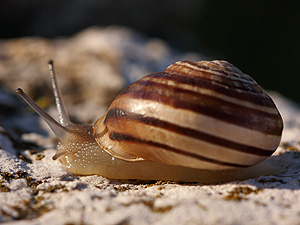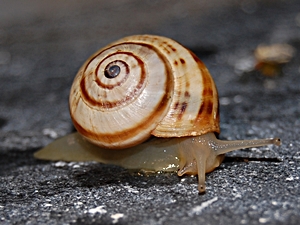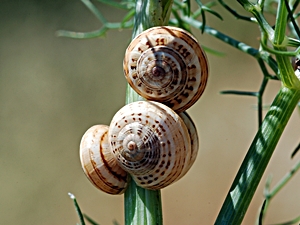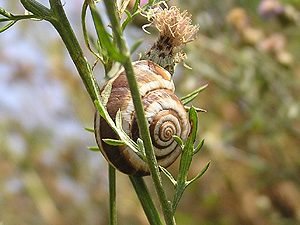|
|
![]() Explanation of
shell characters as means of identification.
Explanation of
shell characters as means of identification.
In some parts of the Mediterranean the Helicidae snail family occurs with an exceptionally large richness in species. Special centres of distribution are Asia Minor (the Asian part of Turkey) and the Balkan peninsula.
Chocolate Banded Snail (Eobania vermiculata).
 Chocolate banded snail (Eobania vermiculata), Rab Island (Croatia). Picture: Andreas Gruber. |
When the Danish malacologist Otto Friedrich Müller first described this species in 1774 after having returned from a journey to Italy (which gave him the right to name the species), he called it "Nudel-Snekken" (noodle snail), because the shell pattern of dissolved stripes reminded him of Italian Vermicelli noodles. Obviously he had not exclusively been occupied with snails during his voyage. Until today the snail is called Eobania vermiculata (O.F. Müller 1774) - only Müller's name is set into brackets; he had described it as Helix vermiculata in 1774.
Description: Compared to other Helicid snails, Eobania vermiculata has got a rather flattened than globular shell, the whorls ascending only little with flat sutures in between. The last whorl descends rapidly towards the aperture (see picture on the left). The apertural lip is evolved noticeably, it completely covers the shell navel (umbilicus). As an adaptation to the snail's usually warm and dry environment, the shell has got a thick wall and a white ground colour. On this there are up to 5 dark brown bands (hence the name chocolate banded snail). The shell bands are often dissolved into separate narrow stripes, overlaid by a whitish net pattern (which led to Müller's choice of name).
 Chocolate banded snail (Eobania vermiculata), Rab Island (Croatia). Picture: Andreas Gruber. |
Dimensions: W: 14 - 27 mm; H: 22 - 30 mm; N: 5 - 6. (Abbreviations).
Habitat and Distribution: Eobania vermiculata lives on dry vegetation on fields and in hedges, often also inhabits agricultural areas, such as gardens and vineyards.
The species is distributed in all of the Mediterranean. In Southern France Eobania vermiculata also extends its area of distribution into the inner country, such as the upper Rhône valley and the upper valley of the Garonne river. In other places in Europe, such as in Bad Schwartau in Northern Germany, in Cologne, and in Györ in Hungary, the species has been introduced. With food transports, it also reached America and Australia. In the United States, Eobania vermiculata has been introduced in Louisiana and Texas, but does not pose a severe threat to agriculture. In Japan, the first naturalized population has been described from Urayasu in the Chiba prefecture. In the meantime another population has been reported from that region.
Economic Importance: In a large part of its distribution area, the
chocolate banded snail is collected as food. This doubtlessly has led to a large
extent to the species current distribution throughout the Mediterranean and
beyond. On Crete, Eobania vermiculata and other terrestrial snails are
commonly sold alive on markets. In France as well, the snail is commonly
referred to as "Morguette" and picked to be prepared as food. In Spain,
Eobania vermiculata is called "Caracol de huerta" (vegetable garden snail),
for obvious reasons.
Further Information:
Sand Hill Snail - Theba pisana (O. F. Müller 1774)
Further vernacular names: White Italian snail, Mediterranean coastal snail. In Italian: Lumachella (Lazio), Babbaluceddu (Sicily), Bovoletto (Venice).
 Sand hill snail (Theba pisana) on Sicily. Picture: Carlo Columba (Source). |
Description: The sand hill snail is a very variable snail species. It has a light yellow to white shell with dark bands or spots and often shows a dark blue grey shell tip (apex). While juvenile shells show a sharp keel, like juvenile Aegopis verticillus, the keel disappears at the apertural whorl of adult shells. The aperture often is rose or red coloured inside and the aperture rim is folded back at the columellar side, covering half of the narrow shell navel (umbilicus).
 Sand hill snails (Theba pisana) in the Camargue. Picture: Fritz Geller-Grimm. |
The sand hill snail can be told apart from other Mediterranean helicid species by the size of its apex and the form of the umbilicus. Juvenile Chocolate banded snails (Eobania vermiculata), for example, relatively have a noticeably larger apex.
The snail's body is light yellow in colour, black stripes leading alongside the body up the larger tentacles. Those are quite long in Theba pisana.
![]() Variations of the Sand Hill Snail (Theba
pisana).
Variations of the Sand Hill Snail (Theba
pisana).
Dimensions: H: 9 - 20 mm; W: 12 - 25 mm; N: 5½ - 6. (Abbreviations). In Greece the shell diameter usually is noticeably smaller.
Habitat and Distribution: The sand hill snail lives on the coast in or near sandy places (hence its name). Theba pisana is able to survive on nearly bare sand with only little vegetation stabilizing the ground. In the hot Mediterranean climate the sand hill snails usually aestivates on grasses, shrubs or succulents. In the North of its distribution area, snails do not aestivate but only crawl up plants in warm weather.
 Maritime garden snail (Cernuella virgata). [RN] |
The sand hill snail often shares its habitat with the maritime garden snail (Cernuella virgata) and the pointed snail (Cochlicella acuta), but it is better adapted to life on the sand and so usually is found more frequently and farther in sandy habitats. But Theba pisana does not survive severe winter frost, which is why its distribution area is limited to the North, for example on the British Isles.
Sand hill snails live in all of the Mediterranean are and the adjacent Atlantic coasts, from central Morocco as far as Belgium and the near Atlantic islands, and also in Israel and Egypt. In Spain the sand hill snail may be found also in the inner country. On the British Isles, where sand hill snails have been introduced during the 18th century, sand hill snails appear in the South, from south-western England to southern Wales as far as eastern and south-eastern Ireland. In most of its area of distribution the sand hill snail is very common near the beaches. From southern Portugal as far as Greece it is among the most frequent terrestrial snails.
Theba pisana has also been introduced overseas: The sand hill snail is found in North America, as well as in South Africa, Australia and Tasmania. In the United States sand hill snails can be an agricultural pests, if they appear in large numbers.
Threat Situation: In
Spain, a coastal subspecies,
Theba pisana arietina, is categorized as endangered (EN) (see also:
![]() IUCN Threat Categories).
IUCN Threat Categories).
![]() Francisco Welter-Schultes:
Theba pisana species homepage.
Francisco Welter-Schultes:
Theba pisana species homepage.
![]() Molluscs of central Europa:
Theba pisana.
Molluscs of central Europa:
Theba pisana.
Reference:
To be continued.